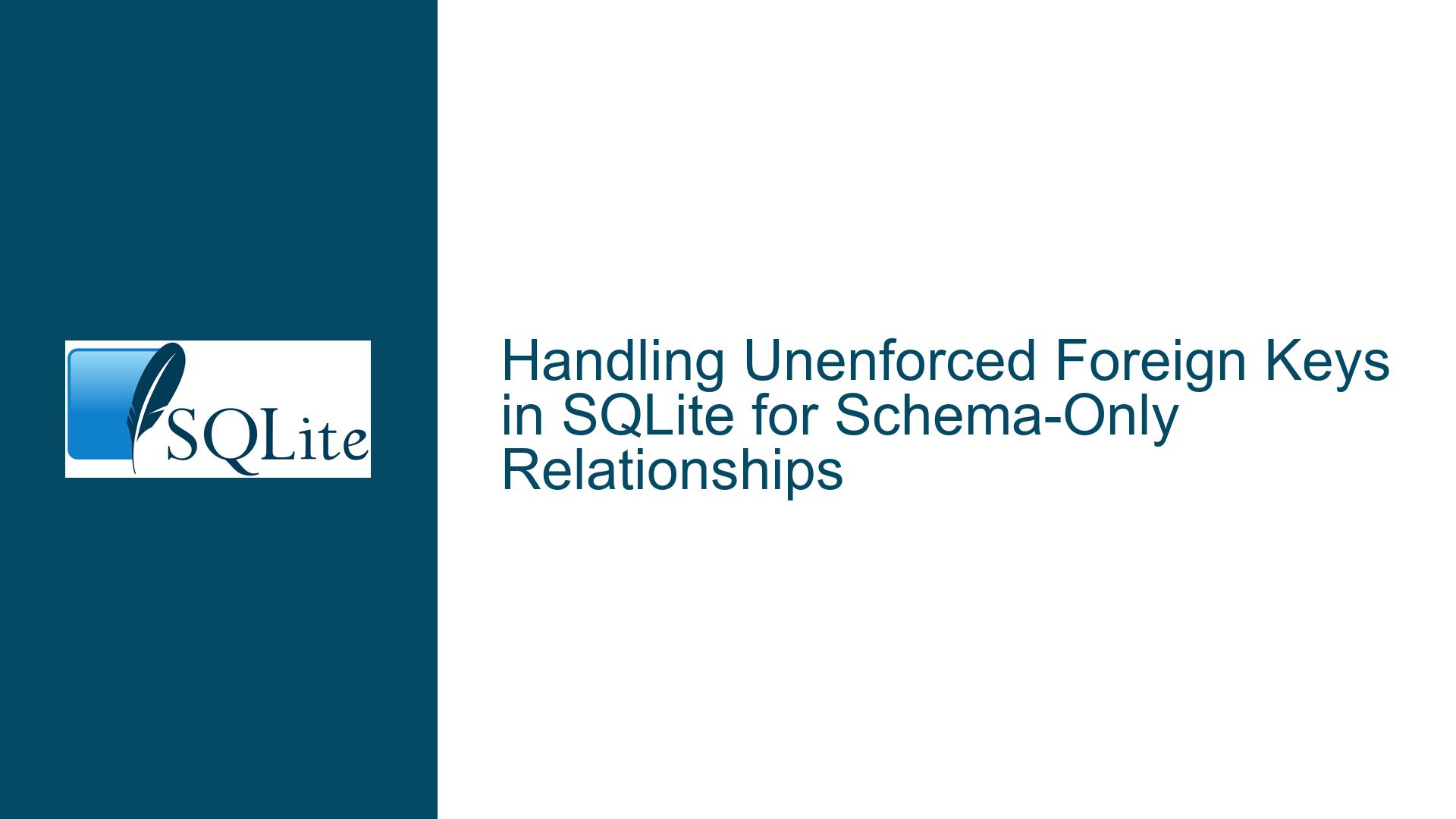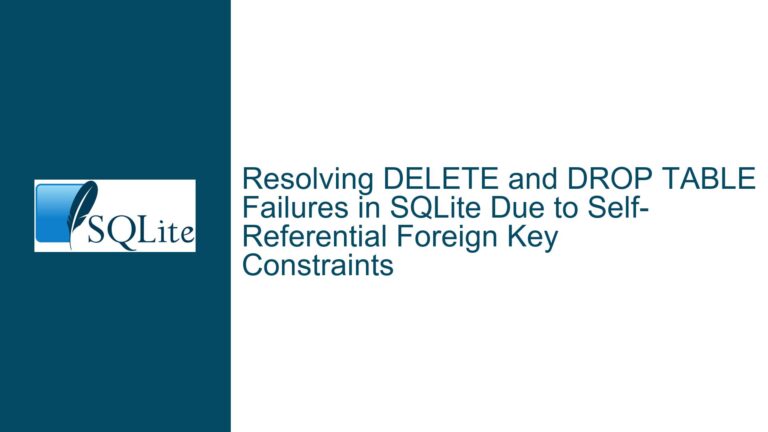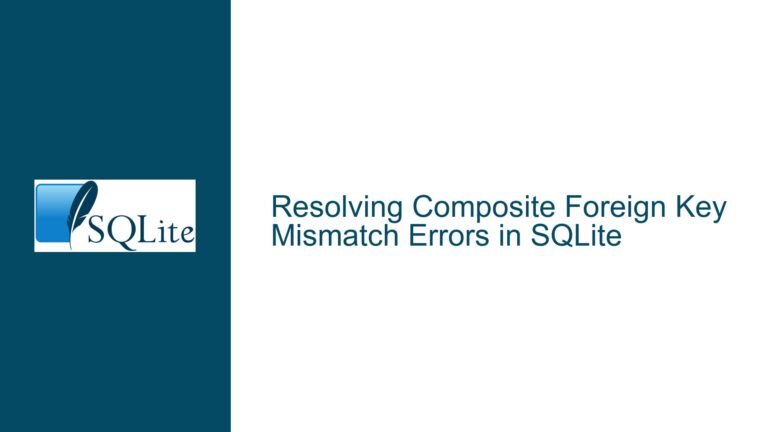Handling Unenforced Foreign Keys in SQLite for Schema-Only Relationships
Foreign Key Constraints in SQLite: Schema-Only Enforcement for GUI Tools
Foreign key constraints in SQLite are a powerful feature for maintaining referential integrity between tables. However, there are scenarios where you might want to declare foreign keys purely for schema documentation or GUI tool compatibility, without enforcing them during database operations. This is particularly useful when working with data models that allow for invalid references, such as when representing JSON graphs or handling soft deletions. In this guide, we will explore the nuances of creating foreign keys that are never enforced, the implications of such a design, and how to achieve it effectively.
Understanding Foreign Key Enforcement in SQLite
Foreign key constraints in SQLite are designed to ensure that relationships between tables remain consistent. When a foreign key is defined, SQLite enforces that any value in the child table’s foreign key column must correspond to a value in the parent table’s primary key column. This enforcement is crucial for maintaining data integrity but can be restrictive in certain use cases.
By default, SQLite does not enforce foreign key constraints unless explicitly enabled using the PRAGMA foreign_keys command. This default behavior is key to achieving schema-only foreign keys. When foreign key enforcement is disabled, SQLite will still recognize and display foreign key relationships in the schema, making them visible to GUI tools and other schema-aware applications. However, it will not enforce these relationships during insert, update, or delete operations.
Use Case: Representing JSON Graphs with Optional Relationships
Consider a scenario where you are modeling a JSON graph as SQL tables. In this model, relationships between entities (such as customers and subscriptions) may not always be strictly enforced. For example, a customer might be deleted, but their associated subscriptions might remain in the database for historical or auditing purposes. In such cases, you want the foreign key relationship between the subscription table and the customer table to exist in the schema but not be enforced during data operations.
To achieve this, you can declare the foreign key in the subscription table without enabling foreign key enforcement. This allows GUI tools to recognize the relationship and provide navigation features, such as jumping to related rows, while still permitting invalid references in the data.
Declaring Foreign Keys Without Enforcement
To declare a foreign key without enforcement, you simply define the foreign key constraint in the table schema without enabling the PRAGMA foreign_keys setting. Here is an example schema for the customer and subscription tables:
CREATE TABLE customer (
id INTEGER PRIMARY KEY,
name TEXT NOT NULL
);
CREATE TABLE subscription (
id INTEGER PRIMARY KEY,
customer_id INTEGER,
plan TEXT NOT NULL,
FOREIGN KEY (customer_id) REFERENCES customer(id)
);
In this schema, the subscription table has a foreign key customer_id that references the id column in the customer table. However, since foreign key enforcement is disabled by default, SQLite will not prevent the deletion of a customer even if there are associated subscriptions.
Implications of Unenforced Foreign Keys
While unenforced foreign keys provide flexibility, they also come with certain implications. The most significant implication is the potential for orphaned records. In the example above, if a customer is deleted, any associated subscriptions will remain in the subscription table with a customer_id that no longer points to a valid customer. This can lead to data inconsistencies if not handled properly.
Another implication is the reliance on application logic to maintain data integrity. Without foreign key enforcement, the application must ensure that relationships are valid before performing operations that could lead to orphaned records. This increases the complexity of the application code and requires thorough testing to avoid data integrity issues.
Handling Orphaned Records
To manage orphaned records, you can implement application-level logic to handle the deletion of parent records. For example, when a customer is deleted, the application can update or delete the associated subscriptions to maintain data consistency. Alternatively, you can use triggers to automatically handle these operations at the database level.
Here is an example of a trigger that sets the customer_id to NULL when a customer is deleted:
CREATE TRIGGER delete_customer
AFTER DELETE ON customer
FOR EACH ROW
BEGIN
UPDATE subscription
SET customer_id = NULL
WHERE customer_id = OLD.id;
END;
This trigger ensures that any subscriptions associated with the deleted customer are updated to have a NULL customer_id, effectively marking them as orphaned but preventing invalid references.
Using ON DELETE SET NULL for Automatic Handling
If you want SQLite to automatically handle the update of foreign key references when a parent record is deleted, you can use the ON DELETE SET NULL clause. This clause specifies that the foreign key column should be set to NULL when the referenced parent record is deleted. Here is an example schema using this clause:
CREATE TABLE customer (
id INTEGER PRIMARY KEY,
name TEXT NOT NULL
);
CREATE TABLE subscription (
id INTEGER PRIMARY KEY,
customer_id INTEGER,
plan TEXT NOT NULL,
FOREIGN KEY (customer_id) REFERENCES customer(id) ON DELETE SET NULL
);
With this schema, when a customer is deleted, the customer_id in the subscription table is automatically set to NULL. This approach maintains the foreign key relationship in the schema while preventing invalid references.
Comparing ON DELETE SET NULL and Unenforced Foreign Keys
Both ON DELETE SET NULL and unenforced foreign keys provide ways to handle optional relationships, but they have different implications. ON DELETE SET NULL automatically updates the foreign key column to NULL when the parent record is deleted, ensuring that no invalid references exist. This approach is useful when you want to maintain some level of data consistency without strictly enforcing foreign key constraints.
On the other hand, unenforced foreign keys allow for invalid references, which can be useful in scenarios where you need to preserve historical data or handle complex relationships that cannot be easily managed with standard foreign key constraints. However, this approach requires careful management of orphaned records to avoid data inconsistencies.
Best Practices for Schema-Only Foreign Keys
When using schema-only foreign keys, it is important to follow best practices to ensure data integrity and maintainability. Here are some recommendations:
Document the Intent: Clearly document the purpose of the foreign key constraints in the schema. This helps other developers understand that the relationships are not enforced and why.
Use Application Logic: Implement application-level logic to handle the deletion of parent records and manage orphaned records. This ensures that data inconsistencies are minimized.
Consider Triggers: Use triggers to automatically handle updates or deletions of related records. This can simplify application logic and ensure consistency at the database level.
Test Thoroughly: Thoroughly test the application to ensure that data integrity is maintained, especially in scenarios where parent records are deleted or updated.
Monitor Orphaned Records: Regularly monitor the database for orphaned records and implement cleanup processes as needed.
Conclusion
Declaring foreign keys without enforcement in SQLite is a useful technique for scenarios where strict referential integrity is not required. By understanding the default behavior of foreign key constraints and leveraging features like ON DELETE SET NULL, you can create flexible data models that accommodate complex relationships while still providing schema documentation for GUI tools and other applications. However, it is important to carefully manage orphaned records and implement appropriate application logic to maintain data integrity. By following best practices and thoroughly testing your implementation, you can effectively use schema-only foreign keys to meet your data modeling needs.






